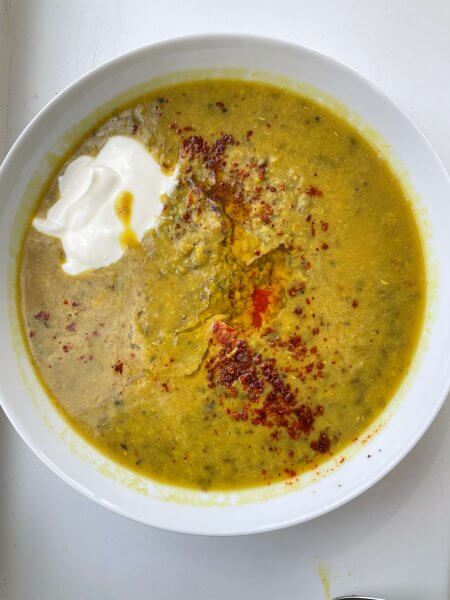I constantly write about the huge variety of dals that are used in Indian cuisine. Mung dal, one of the most nutritious foods one can eat, and a huge part of Ayurvedic nutrition, is cooked whole,or split (with half the green skin still on) or skinned (yellow). Each one renders a meal slightly different in taste and texture, but for me, there is no favourite, as they are all exquisitely wholesome and delicious. This chilka (meaning skin) dal is the prettiest colour combination of green and yellow, and has the creamiest taste. It can be made thick or slightly more watery depending on preference.

Washing and soaking lentils is so important. My mother tends to wash and soak them in the morning before cooking them for lunch or an evening meal. Don’t rush and think it’s ok not to bother with this preparation, because you will possibly find you don’t digest them well, and will tend to blame it on an intolerance. Lectin, a type of protein found in many plants, including legumes, plays a protective role for them, but it is difficult for humans to digest. However, washing, soaking and slowly cooking the food breaks it down and makes them easily digestible (Ayurvedic medicine always insists on cooking vegetables, and the wisdom of the Ayurvedic sages was so profound, they realised soaking dal was essential for proper digestion). In fact, mung beans are one of the most easily digested foods you can eat.
Ingredients to serve 4-6 people are a main meal with chapati or rice:
200g split mung beans
1/2 tsp turmeric powder+a pinch more
2 level tsp ground cumin
2 level tsp ground coriander
2 level tsp grated fresh ginger
A small green chilli, slit lengthways
1 tbsp lemon juice
1 tbsp grated jaggery
1 tbsp ghee and a tsp rapeseed oil
1/2 tsp cumin seeds
1/2 tsp black mustard seeds
A small dried red (kashmiri) chilli
2 tbsp chopped tomatoes
Salt to taste
A small handful of fresh coriander leaves, chopped
Method:
Put the dal in a medium sized cooking/casserole pan, and wash it in hot water three times, massaging it well with your fingers and draining the cloudy water each time. By the third wash, the water will look clear. Add very hot water to the dal to more than cover it (it will expand when soaking) and soak for at least three hours.
Once you are ready to cook, heat the dal in its water on a medium heat and when it’s boiling, cook it for around 20 minutes more, with a lid partially on, until the dal is very soft. Allow it to cool a little and, using an electric hand blender, blend for a few seconds until around half of it is smooth (you want to retain some of the texture of the dal so don’t go mad and blend for too long).
Put the pan back on the heat and add the turmeric, ground cumin and coriander, the green chilli, ginger, lemon juice, and jaggery. Add around two level teaspoons of good quality salt, and gently boil for around 5 minutes. Turn the heat down to minimum while you start on the final bit.
Heat the ghee and oil on a medium heat in a very small frying or cooking pan, and when it is hot, throw in the mustard and cumin seeds. Once they fizzle, add the dried red chilli and a pinch of turmeric, mix well and add the tomatoes. Let it cook for no more than 2-3 minutes until the tomatoes are thickened and fully incorporated. Now carefully add a ladleful of the dal into this mixture before pouring the lot back into the dal pan. Mix thoroughly and let it cook on a medium heat for 5-10 minutes.
The flavour should be both subtly sweet and sour. You can add a little more lemon juice and/or jaggery to balance the taste and you might need a little more salt too, so adjust everything before serving. Experiment and practice fine tuning the taste…it can take years to get this tweaking right.
Serve with a little fresh yoghurt on the side if you’re having it for lunch (I don’t advise yogurt in the evening). The picture shows it served topped with a Gujarati homemade fenugreek chilli powder, that I love. But you can serve it garnished with the coriander leaves, and serve it with chapatis, rice, flatbread, or even as a soup with some gorgeous bread.
